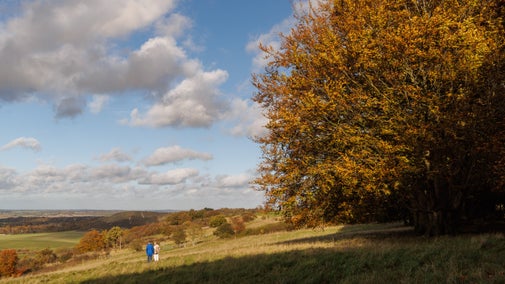Dunstable Downs Five Knolls wildlife and heritage walk
Essex, Bedfordshire & Hertfordshire
Walk up on the downs on this all-weather out-and-back pathway that's ideal for families. Enjoy the views from this site, which has been an important vantage point to people for over 1,000 years. And keep an eye out for the rich variety of birds, insects and plants that make their home here on the chalk downs.
Start point
Chilterns Gateway Centre visitor car park, LU6 2GY. Grid ref: TL008195.Trail information
Accessibility
This is a great walk to do on wheels, suitable for buggies, motorised scooters and wheelchairs. Numbered and lettered waymarkers mark the route.
More near here
Dunstable Downs countryside walk
Follow this moderately difficult circular route through Dunstable Downs, discovering diverse wildlife, ancient tracks and burial mounds.

Whipsnade and Dunstable Downs walk
Suitable for more energetic families, the Whipsnade and Dunstable Downs walk offers wonderful views across the Downs.

Get in touch
Our partners

We’ve partnered with Cotswold Outdoor to help everyone make the most of their time outdoors in the places we care for.
You might also be interested in
Eating and shopping at Dunstable Downs
Enjoy stunning views and tempting treats in the café’s large indoor and outdoor seating areas. Discover seasonal and locally sourced gifts in the shop for a souvenir of your visit.

Top accessible walks
Discover the best accessible trails to explore with pushchairs, wheelchairs and mobility aids across the places we look after. Get out in nature without having to go off the beaten track.

Walking in Essex, Bedfordshire and Hertfordshire
From long forest wanders to a gentle amble to a famous literary hut, these are some of the best walks around Essex, Bedfordshire and Hertfordshire.

Walking
Explore some of the finest landscapes in our care on coastal paths, accessible trails, woodland walks and everything in between. Find the best places to walk near you.

Staying safe at National Trust places
The special places in National Trust care sometimes come with a few risks for visitors, be it coastline or countryside. Find out how to keep safe throughout your visits.

Follow the Countryside Code
Help to look after National Trust places by observing a few simple guidelines during your visit and following the Countryside Code.

Cotswold Outdoor: our exclusive walking partner
Learn about the National Trust’s ongoing partnership with Cotswold Outdoor. Find out how they help us care for precious places and the exclusive discount available for National Trust supporters.


